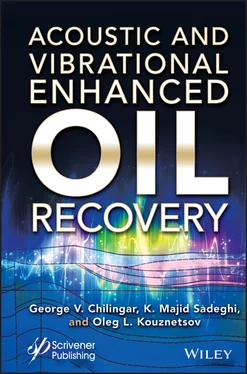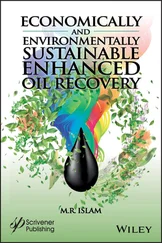7 Chapter 7Figure 7.1 Elastic wave intensity corresponding to minimum threshold values of o...Figure 7.2 Laboratory setup layout to diagnose acoustic radiations of the stress...Figure 7.3 Schematic of the measuring system.Figure 7.4 Screenshots of the restored core-medium state attractors at various l...Figure 7.5 Initiation of AE signals from the oil-saturated core exposed to recta...Figure 7.6 Variation of energy releases E along the time series N after the load...Figure 7.7 Results of AE signal wavelet analysis after the load increase, type r...Figure 7.8 Specific AE energies and frequencies and mechanical stress energy acc...Figure 7.9 Results of the post-loading AE signal wavelet analysis typical for oi...Figure 7.10 AE energy initiated by weak pulse wave impact, for cores with differ...Figure 7.11 Dimensionless in situ ∆ P * pressure variation at various r distances ...Figure 7.12 Distribution of dimensionless pressure ∆ P * in the reservoir under in...Figure 7.13 Pressure distribution in the reservoir under combined wave and press...Figure 7.14 The bottomhole-pressure variation during the integrated wave and pre...Figure 7.15 Bottomhole-pressure variation curves for well 376 in the Dachno-Repn...Figure 7.16 Variation of the AE signal count N* functional during loading at two...Figure 7.17 Variation of the AE signal count N* functional during loading at two...Figure 7.18 Variation of the AE signal count N* functional during loading at two...Figure 7.19 Variation of the AE signal count N* functional during loading at two...Figure 7.20 Variation of the AE signal count N* functional during loading at two...Figure 7.21 Variation of the AE signal count N* functional during loading at two...Figure 7.22 Isolines of threshold values of the oscillatory acceleration and dis...
8 Chapter 8Figure 8.1 Typical schematic and outer appearance of hydrodynamic generators.Figure 8.2 STRENTER system configuration.Figure 8.3 Bench performance of the GD2V-4,5 oscillation generator.Figure 8.4 STRENTER system layout sketch to run near-wellbore zone treatment usi...Figure 8.5 Inflow profiles for Prirazlomnoye well 808 before and after the VDHV ...Figure 8.6 Injectivity profiles for the Novo-Elkhovskoye well 3468 prior and aft...Figure 8.7 Near-wellbore zone flow properties and productivities of the Tuymazin...Figure 8.8 Equipment layout scheme and configuration of the downhole oscillation...Figure 8.9 Main stages of the GRVP technology stages.Figure 8.10 Cumulative incremental oil production and number of well-operations ...Figure 8.11 Injectivity profiles for well 757 of the Igrovskoye Field before and...Figure 8.12 The exterior of the GD2V-2K generator attached to the coiled tubing.Figure 8.13 Wellhead pressure profile for the injection well 8030 Romashkinskoye...Figure 8.14 Bottomhole pressure and temperature profile for producing well 3269 ...Figure 8.15 Progress of the oil-acid fracturing process in time based on analysi...Figure 8.16 Stage diagrams of the hydraulic oil-acid fracturing progress in the ...Figure 8.17 General view of the seismic vibrator MERTZ M/20.Figure 8.18 The exterior of the seismic vibrator MERTZ M/20 base plate.Figure 8.19 Performance behavior of the Yugomashevskoye wells, lower Carbonifero...Figure 8.20 Yugomashevskoye wells performance, Area 2 (terrigenous lower Carboni...Figure 8.21 Yugomashevskoye wells performance (lower Carboniferous terrigenous f...Figure 8.22 Yugomashevskoye wells performance, Area 1 (lower Carboniferous terri...Figure 8.23 Yugomashevskoye well 2308 performance behavior, Area 1 (lower Carbon...Figure 8.24 Performance history of well 1738, Yugomashevskoye field, Area 1 (low...
9 Chapter 9Figure 9.1 Rate of oil recovery from natural core samples in the presence and ab...Figure 9.2 Degassing of CO 2-saturated water in the presence of elastic waves.Figure 9.3 Relative permeabilities to oil and to water (three-phase fluid flow)....Figure 9.4 Cumulative fluid production cm 3as a function of oil recovery (%) bef...Figure 9.5 Dependence of the oil recovery on water salinity (1) in the presence ...
10 Chapter 10Figure 10.1 Cumulative oil production as a function of cumulative water producti...Figure 10.2 Cumulative oil production as a function of cumulative water producti...Figure 10.3 Cumulative oil production as a function of cumulative water producti...Figure 10.4 Water/oil ratio as a function of cumulative water production before ...
11 Chapter 11Figure 11.1 Generic relative permeability curves, for preferentially water wet r...Figure 11.2 Enhanced oil recovery modification of oil/water (k o/w) and water/oil...Figure 11.3 Generalized rock/soil charging and discharging current (after Hill, ...Figure 11.4 Generalized rock/soil charging/discharging potentials (after Hill, 1...Figure 11.5 Schematic representation of polarizable rock/soil as a mesoscopic di...Figure 11.6 Schematic representation of Figure 11.5. Rock/soil polarized by an e...Figure 11.7 Schematic representation of energy requirements of various electroki...Figure 11.8 Schematic representation of NaCl dissolved in water (after Hill et a...Figure 11.9 Silicate tetrahedra linkage (after Berry and Mason, 1959 [12]). (a) ...Figure 11.10 Schematic representation of the formation of the Helmholtz Double L...Figure 11.11 Montmorillonite crystal structure showing interlayer water and exch...Figure 11.12 Pore throat schematic showing double layers forming adjacent to cla...Figure 11.13 Schematic representation of the formation of a cation-selective mem...Figure 11.14 Pore throat schematic showing electrokinetic transport of the outer...Figure 11.15 Relationship between potential gradient and normalized electrokinet...Figure 11.16 DCEOR Field Operation Schematic Rendering (after: Amba et al. , 1965...Figure 11.17 Three-layer earth DCEOR field mapping model (after Wittle and Hill,...Figure 11.18 DCEOR Figure 11.18 model simulation equipotential field cross-secti...Figure 11.19 DCEOR Figure 11.17 model simulation equipotential field plan view (...Figure 11.20 DCEOR simulation results: Reservoir temperatures after 100, 1,000, ...Figure 11.21 DCEOR simulation results: Comparison of AC and DC electrical power ...Figure 11.22 Santa Maria Basin (California, USA) short-term DCEOR demonstration,...Figure 11.23 Lloydminster Heavy Oil Belt (Alberta, Canada) DCEOR field demonstra...Figure 11.24 EC PAH destruction documented by GCMS changes, with time, during tr...Figure 11.25 Laboratory San Joaquin Valley (California, USA) heavy oil field res...Figure 11.26 California, USA, Heavy Crude viscosity changes during DCEOR laborat...Figure 11.27 Changes in effective permeability, due to the passage of DC current...
12 AddendumFigure A.1 Electrodes arrangement for acidizing operation.
1 Chapter 4Table 4.1 Saturating fluid description at a study of heat conductivity in a vibr...
2 Chapter 5Table 5.1 The absolute permeability effect on the oil gravity flow on reservoir ...Table 5.2 The duration of gravity separation for the static balance of oil visco...Table 5.3 The computation results for the oil saturation stationary distribution...
3 Chapter 8Table 8.1 Wave treatments.Table 8.2 Wave methods to treat the near-wellbore zone (aimed to enhance well pr...Table 8.3 Methods of wave reservoir treatment (aimed to enhance oil recovery).Table 8.4 Types of generators, their technical specifications, and purposes.Table 8.5 Downhole IS-type jet pumps.Table 8.6 Results of bench hydrodynamic generator tests.Table 8.7 The results of using VDHV technologies in various reservoirs of the No...Table 8.8 HydroVibroFrac technology performance indicators.Table 8.9 The geological and production data of the productive reservoirs and ph...Table 8.10 Seismic vibrator MERTZ M/20 technical specification.Table 8.11 Operating regimes of seismic treatment.Table 8.12 Results of VST treatments in the fields of the Bashneft oil company.Table 8.13 Target reservoirs and conditions for implementation of integrated tec...
Читать дальше












